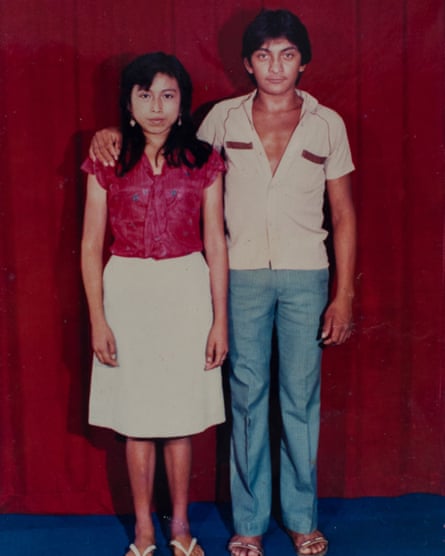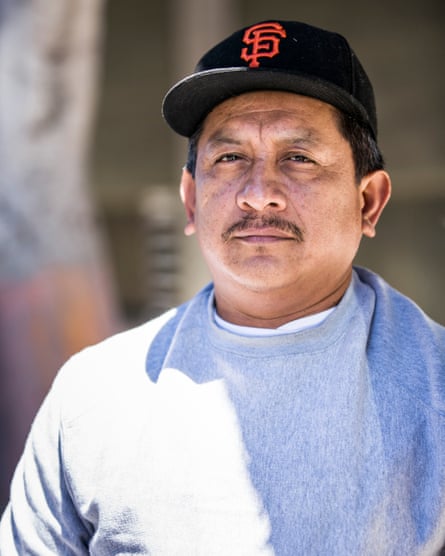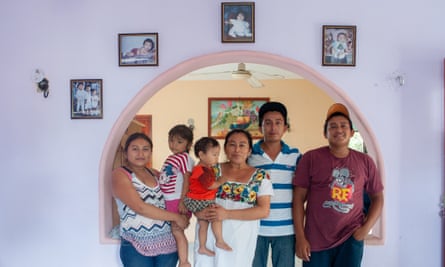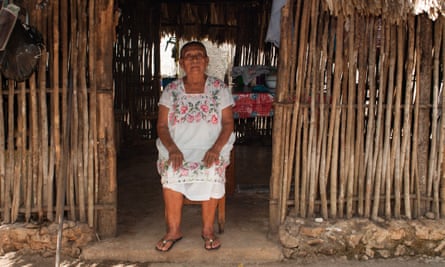The man walked down the sidewalk, the blade of a kitchen knife glinting in his hand.
He had taken a break from playing soccer with an old basketball on the tree-lined street in San Francisco’s Mission District.
Now he sat on the ground, his back against a building. Three pedestrians passed by, walking at a steady pace, apparently unperturbed.
“Get on the ground! Get on the ground!”
Two police cruisers had pulled to a stop, blocking the street.
Sergeant Nate Seger and officer Mike Mellone had stepped out of their cars, shouting as they walked toward the man.
“Get on the ground! Put that down!”
One of the officers carried a bean bag rifle. He cocked it and fired three times.
As the fourth – and final – beanbag round was dispelled, the second officer began firing with live ammunition. Bang. Bang. Bang. Bang. Bang. Bang. Bang. Seven shots.
It was the shot to the head that killed the man. The bullet entered at the top of his skull, above his left eye, and exited at the base of his skull, behind his left ear.
The man known in the neighborhood as “the homeless guy with the soccer ball” was dead.
In San Francisco, one out of every 200 people sleeps on the streets each night.
They have lost their homes, and they have lost their names: to homeowners, to apartment dwellers, to politicians, and often to each other, they are only “the homeless”.
But the homeless man who was killed by police on the streets of San Francisco, on 7 April 2016, had a name, and he had a home.
His name was Luis Demetrio Góngora Pat, and his home was a modest, one-story house a few blocks from the central square of the tiny Mayan village of Teabo, in the Mexican province of Yucatán.
It was a house built slowly, room by room, over the course of seven years, with the remittances Luis Góngora sent home from San Francisco.
It was a home Luis Góngora never set foot in.
“He left so he could build this house,” said Fidelia del Carmen May Can, Góngora’s widow, as she sat in her sun-filled living room with pictures of her children on the walls, a San Francisco Giants cap on the shelf, and a shrine of flowers, candles, icons, and a framed photograph of her husband on a small table.
“I want people to know that we are without him. The hope of being with him no longer exists.”
The life and death of Luis Góngora occurred at the intersection of twin crises: homelessness and police killings. Amid a tech-fueled economic boom, the major cities of the US west coast have become as notable for their sprawling homeless encampments as they are for their billion-dollar companies.
Seattle has Amazon, and the Jungle. Los Angeles boasts Snapchat, and Skid Row. Throughout San Francisco, tent cities compete for space on the sidewalks with the hordes of employees of firms such as Twitter, Google, LinkedIn, and Airbnb.
The encampments can be magnets for crime – and police.
No one tracks police brutality against the homeless, but a review of media reports reveals that at least thirteen of the 1,146 people killed by police in 2015 were homeless. Given a homeless population of about 565,000 in 2015, that means the homeless were 6.5 times more likely to be killed by police than the rest of the population.
The plot of sidewalk where Luis Góngora pitched his tent for the last few months of his life is about 3,000 miles away from where he grew up.
Teabo is a poor village, but even there, Luis Góngora’s family’s poverty stood out . His father, Demetrio, worked as an assistant for the local butcher, where he was paid in meat rather than cash. His mother, Estela, raised nine children in a one-room Mayan hut with a thatched palm roof and dirt floor. She rose at 5am each day to prepare the k’eyem (corn flour mash, diluted in water) for the family to drink for breakfast.
When the children were sick, there was no money for medicine, so Demetrio treated their ailments with traditional herbal medicines.
Perhaps because of this poverty, Luis Góngora would eat anything. He shot loros – small green and yellow parrots with just a few ounces of meat on them, if that – out of trees with a slingshot, and prepared them like poultry. If he came across a deer, he would try to shoot it and lug it home. The fat black iguanas that skulked among the rocks were good for a meal as well.
When Luis Góngora was just 12 years old, he left school and went to work. His younger brother, José, followed a few years later. The pair were the youngest of the Góngora siblings, and wherever Luis went, José followed. They did not like school, never learned to read, and were both more comfortable speaking Mayan than Spanish.
“We dedicated ourselves to the fields,” José Góngora said.
Góngora met his future wife, Fidelia del Carmen, when they were 14. They married at 20 and, as their family grew – first two boys, then a girl – Luis began to travel to Cancún to find work.

There are no jobs in Teabo, as in many of the other predominantly Mayan, rural towns that dot the jungle of Yucatán. The ejido – communal farm land – provides food to eat, but for clothes, shoes, and medicine, cash is required. Many men travel to Cancún, Mérida, or Chetumal six days a week – or for an entire tourist season – to earn money to support their families. But those who can put together the fee for a coyote – a guide paid to smuggle migrants across the border – usually go to San Francisco.
The migration corridor between Yucatán and San Francisco was established one border crossing at a time. As word of mouth and family connections grew, it turned into something of a migration highway in the early 2000s. There are estimated to be 50,000 Yucatecan migrants in the San Francisco Bay Area, 90% of them undocumented, 80% of them Mayan-speaking, and 70% of them male.
Thousands of Yucatecos work in the kitchens of San Francisco’s thriving restaurant scene, and the wages earned there are visible in the landscape of Yucatecan towns, where construction workers and modern houses are a sure sign of a relative in San Francisco.
A few blocks from the central square of Oxkutzcab, a neighboring town to Teabo, a two-story structure featuring the iconic bay windows of San Francisco’s Victorian townhouses rises above a dusty intersection. The Hotel Capitol was built over 14 years by a cook working at a restaurant in San Francisco’s Ferry Building. Murals of the Golden Gate Bridge and cable cars adorn the walls.
Down the street, the Restaurant iCafe offers sushi, crepes, hamburgers, and Italian, Chinese, and Mexican food, thanks to the two chefs’ experience working in San Francisco restaurants.
“You can find everything in San Francisco,” said Marcelino Burgos, a migrant who returned after several years working in San Francisco’s Chinatown, as he sat in the shade outside his house in Oxkutzcab.
“Now I dream of walking those streets.”

As Luis and José Góngora struggled to support their growing families on their efforts in the ejido, the brothers began to look northward, as so many others had done before them.
It was José Góngora who first accepted the invitation of one of his older brothers to join him “somewhere north”, in 2001. Their mother pawned her gold earrings to pay the fee for a coyote, and José arrived in San Francisco on September 11. The first thing he saw was news footage of the Twin Towers falling.
Assisted by a network of cousins already established in San Francisco, José Góngora soon found work as a dishwasher and began sending money home.
As José Góngora’s wife, Julia, began to build her house, Luis Góngora, whose family still lived in a Mayan hut in the land behind his parent’s house, itched to join his brother. He sold a horse and a summer’s harvest and left for San Francisco in September 2002.
The 31-year-old migrant could be forgiven for having high expectations. Luis Góngora’s cousin and childhood friend, Luis Armando Poot Pat, had been living in San Francisco for 12 years, and his experience hewed closely to the American dream. After arriving in the US, Poot had found work at a restaurant as a janitor.
Twenty-six years later, Poot is the manager at the same restaurant. His wife and children were able to join him in San Francisco. One of his sons is studying biochemical engineering at the University of California, Santa Cruz.
When Poot ran across Luis Góngora at the main intersection of the Mission district, a historically Latino neighborhood where the Yucatecos often cross paths, he was able to quickly set his cousin up with a job as a prep cook at Mel’s Diner, a 1950s throwback restaurant where the milkshakes are thick and the staff wear white paper caps and bow ties.
After bouncing around different buildings in the Mission for a few years, Luis and José Góngora settled in an apartment at 1751 Market Street, where they roomed with another man from Teabo, who they called El Torero.
A non-descript apartment building upstairs from a popular piano bar, 1751 Market became known as San Francisco’s most “nightmarish”, “disgusting” apartment building when a group of tenants sued the landlords for $10m in 2014. The lawsuit revealed the hellish conditions – mold-encrusted walls, crumbling ceilings, busted plumbing in communal bathrooms, visible nests of bed bugs, rodents and cockroaches. It was there Luis and José Góngora spent some of their happiest years.

Matthew Castro, a waiter at Mel’s who quickly became best friends with the brothers, recalled the time at 1751 Market fondly.
A close-knit group of five – the Góngora brothers, Castro, El Torero and his brother – they would hang out on the twin beds in the single room they rented, cooking food on the hot plate. The Góngora brothers would collect beer cans after a night drinking and return the recycling to Safeway for extra cash.
“We would always be listening to music, watching soccer, eating, laughing, just bullshitting about life,” Castro said. “There wasn’t a worry. We were all working.”
And the work was paying dividends back in Teabo, where Luis Góngora’s money was building the house for his family, and his children remained in school well past the age of 12.
But as the edifice rose in Teabo, cracks in the foundation were beginning to spread in San Francisco.
The life of a Yucatecan migrant in San Francisco can be lonely.
“You start to drink to forget things,” is how Marcelino Burgos, the migrant who returned to Oxkutzcab, described the experience of being far from his family and working night and day among people who rarely spoke his language.
“Everyone cries,” he said.
Luis Góngora lost his job at Mel’s Diner around 2010 or 2011. Most of the employees in the kitchen who spoke Mayan left, Poot explained, and without them to translate, Góngora was unable to do his job and got fired.
He found another job at another restaurant with Mayan speakers for about two years, but when they left, he was unemployed again.
“He got really frustrated because he didn’t have money to send to Mexico,” Poot said. “He found other work, but he had issues. No other people speaking Mayan – he couldn’t get a stable job. He was short of money.”
El Torero, the roommate, left San Francisco and returned to Teabo to pursue his dream of being a bullfighter. (He died, gored by a bull, in 2013). José Góngora found a job in the suburbs, doing landscaping work, and returned to the apartment infrequently.
It was around this time, Castro said, that Luis Góngora’s drinking and marijuana use transitioned into more serious drug abuse. Another Yucatecan in the building was dealing heroin, and Castro believes Luis Góngora got hooked.
José Góngora says that he never saw his brother using hard drugs, but he was not around much to see.

It is unclear exactly how the brothers came to be evicted from 1751 Market. José Góngora says that he was still leaving money for rent, but he doesn’t know if the money made its way to the landlord. Poot says that, once El Torero left town, the Góngora brothers struggled to “manage the household” since neither could read or speak English.
Either way, in the fall of 2013, José Góngora returned to the Market Street building to find his apartment locked and his belongings in the trash. He salvaged a bag with some photographs and personal items and was out on the street.
Homelessness was a harrowing experience for both of the brothers, and the crisis forced them in different directions. José Góngora stayed with friends for a few days, and then found a room in a residential hotel for a week.
“First I lost my home, and then I lost my job,” he said. “I had this bag of stuff. How was I going to arrive at work with this bag of stuff?”
The brothers lost track of each other.
“When I was living on the street, I saw Sapo once,” José Góngora said, using a family nickname for his brother. “I said, ‘Where are you living? On the street also?’ I said, ‘Each one of us is on our own path.’”
José Góngora later slept in public transit stations or on buses. One day he went to the police station, hoping to turn himself in and get deported to Mexico. The police told him to go away, unless he wanted to be locked up.
After two weeks of sleeping in a park, José Góngora convinced his cousin Poot to take him in. It wasn’t easy. José was skinny and unclean, but more than anything, Poot said, he was traumatized.
Poot took over, imposing strict rules and caring for José Góngora until he recovered. Poot found him a new job, stopped him from drinking, and took control of his finances, sending all of his wages back to his family.
“José has always been well-behaved. When they were kids, Luis was like the boss, the dad. José was the one following orders,” Poot explained.
Since 8 November 2013 – the day Poot accepted him into his house – José Góngora has not had a single beer or sip of alcohol.
“No beer, no marijuana, only work,” José Góngora jokes.
Poot tried to arrange a similar rescue for Luis Góngora, who was still on the streets, but with little success.
“Luis always wanted to make his own decisions,” Poot said. “I don’t know. If Luis had come knocking on my door instead of José, maybe I would have helped him instead, but fate put José in my path.”
Poot’s brother, Wilberto, tried to take Luis Góngora in, but he didn’t follow the rules of the house – not going out at night and ringing the doorbell, staying out of sight of the landlord – and it didn’t work. Poot paid for Luis Góngora’s documents to be sent to San Francisco so he could send his cousin back to Mexico, but Luis lost the papers. Another relative took Luis Góngora to live in San Jose, but again Luis returned to the streets.
“I didn’t know how to help him,” Poot said. “He had no house, no money, no job, no papers – so many issues.”
The longer he was homeless, the worse Luis Góngora’s mental state seemed to get.
“He would be confused when he was talking to you. Sometimes he would be fine, and sometimes he would just be talking to himself on the street,” Poot said.
For a while, Luis slept on the sidewalk in front of the building where his brother and cousin lived in an apartment with Poot’s wife and children.
“I was very sad, because I told him at some point, don’t come knocking on the door because if the owner sees you, he might be given a reason to throw us out,” Poot recalled.
Despite his downward spiral in San Francisco, Luis Góngora kept up appearances with his family in Teabo. He never told them that he was homeless. He didn’t talk about himself.
“The saddest part is that the family is learning now how he was living. Luis’s mom asked me, ‘Why didn’t you tell me?’” Poot said. “I never told them because I thought it would cause them sadness.”

José Góngora was at the laundromat on 7 April when he heard police sirens. He didn’t think of it again until the next day, when he was at work. He had a bad feeling. He told his manager that he needed to leave early, that he needed to go look for his brother.
When he arrived at the homeless encampment where Luis Góngora had been living for the past few months, José Góngora asked for his brother’s whereabouts by miming kicking a soccer ball. A homeless outreach worker from a neighborhood non-profit grabbed his arm and said, “Get your strength.”
“It’s very important for us Mayans, once a person is dead, to honor them,” Poot said. “When you’re alive, you can defend yourself, but once you’re dead, you have to honor them. In the Mayan culture, a deceased one is sacred.
“Luis is never going to die. As long as we remember him, he is going to live with us. We’re always going to honor him.”
The broad details of Góngora’s death are made plain by security video provided to the Guardian by a neighbor who asked to remain anonymous because he feared police retaliation. The camera caught images of Góngora in his final hours, the arrival of the police, and audio of the beanbag and live ammunition being fired.
What is in dispute are the exact actions of the police and Góngora during the final 30 seconds that led up to the shooting.
Góngora was sitting just out of the frame of the video footage. The story of his killing can only be composed by the testimony of the police who killed him and the witnesses who saw it happen.
The fatal encounter was set in motion when two homeless outreach workers went to the homeless encampment where Luis Góngora lived, responding to a report that a baby was crying. The workers did not find a baby, but police say the outreach workers saw Góngora “swinging [a knife] indiscriminately as he walked down the street”, prompting them to call the police.
Former San Francisco police chief Greg Suhr told members of the public that Góngora was “seated on the sidewalk with a large knife and the blade pointed up” when police officers arrived on the scene. (Suhr was fired in May shortly after San Francisco police shot and killed an unarmed black woman in a car.)
“They tried to shoot him in the arm to get him to drop the knife,” Suhr told reporters when asked why police officers deployed beanbag rounds at a seated man.
The San Francisco police department alleged that, after being struck by the beanbag rounds, Góngora stood up and “charged”, “lunged” or “ran at” at the officers with the knife, prompting them to fire in self-defense.
The Guardian has interviewed six eyewitnesses to the shooting. They include three homeless residents of the encampment who were standing on the sidewalk about 20 yards from the shooting, two residents of apartments overlooking the street, and one pedestrian who was on the sidewalk opposite to the incident. All of them contest the police version of events.
“I would by no stretch of the imagination say that he was charging them,” said S Smith Patrick, a documentary film-maker who had an unobstructed view of the shooting from her second-story window across the street. “His body was recoiling from bullets.”
The incident is subject to three independent investigations, by the police department, the San Francisco office of citizen complaints, and the district attorney. A civil rights attorney representing Góngora’s widow and children has filed a claim against the city of San Francisco, a precursor to a civil lawsuit for wrongful death and excessive force.
“Based on multiple eyewitness accounts that are part of our preliminary investigation, Luis Góngora lunged at one of our officers with a large knife,” a spokesman for the city attorney said in response to the lawsuit. “Góngora posed an immediate and deadly threat, and our officers’ use of lethal force was necessary and legally justified.”
The legal process is likely to take years, a fact that is difficult for Góngora’s family in Teabo to accept.
Góngora’s mother, Estala, cried as she sat in a hammock in her house in Teabo. As the 87-year-old woman broke into tears, no one reached out to touch her or comfort her. Instead, her daughter-in-law and granddaughter grabbed pillows and began to fan her with cool air from behind.
“I want to know,” she said, “if before I die there will be justice for Luis.”
In the living room of Luis Góngora’s house, Maria Guadalupe Cruz sat in a chair before a shrine to her brother-in-law Luis, leading a roomful of women in el rezar – the prayer.
It was 7 July, the morning after police in Falcon Heights, Minnesota, shot and killed Philando Castile during a traffic stop and two days after police in Baton Rouge, Louisiana, shot and killed Alton Sterling while he was selling CDs.
The deaths of those two men made international headlines, sent protesters into the streets across the US, and drew the attention of Barack Obama, but here in Teabo, 7 July was the three month anniversary of a tragedy that continues to play out on a smaller stage, in the living room of the house that the homeless man built.
“Cuando te rezo, puedo comprender que una madre no se cansa de esperar,” Cruz sang. “When I pray to you, I understand that a mother does not get tired of waiting.”
Teabo is a woman’s town, and a town where the women have grown accustomed to waiting.

They wait for their husbands, fathers, and sons to come home from the places they go to find work: the ejido, the big cities of Yucatán, or San Francisco.
Luis Góngora left Teabo almost 14 years ago. He did not see his three children grow up, his wife mature into middle age, or his parents grow old. He never met his two grandchildren. He did not see his family move out of the Mayan hut with a palm-leaf roof and dirt floors and into the one-story house with two bedrooms, a kitchen, a living room, and a bathroom that was built with the money he sent home from San Francisco.
He never slept on a hammock slung between the hooks on the walls, or ate in the kitchen where his relatives gather around the table to honor his memory by eating his favorite dish.
Luis Góngora’s presence is not missing from these rooms, because it never was here. But what is missing from the Góngora household, from his wife Fidelia de Carmen, from his children Luis Rudolfo, Angel, and Rosana, from his nieces and nephews and his mother and father – what is missing is the presence of the hope that he might one day return.
“He left a long time ago,” said Demetrio, Luis’s father. “Even though I didn’t see him, I knew he was alive.”
“Sometimes I don’t accept that he is dead, because he used to say he would come back to meet his grandchildren,” said Rosana, Luis’s daughter, whose own daughter is two years old.
“Sometimes I imagine that he is still alive.”
